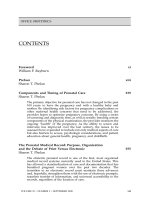Medical Informatics in Obstetrics and Gynecology pdf
Bạn đang xem bản rút gọn của tài liệu. Xem và tải ngay bản đầy đủ của tài liệu tại đây (7.26 MB, 429 trang )
Medical Informatics in
Obstetrics and
Gynecology
David Parry
University of Technology, New Zealand
Emma Parry
The University of Auckland, New Zealand
Hershey • New York
Medical inforMation science reference
Director of Editorial Content: Kristin Klinger
Director of Production: Jennifer Neidig
Managing Editor: Jamie Snavely
Assistant Managing Editor: Carole Coulson
Typesetter: Larissa Vinci
Cover Design: Lisa Tosheff
Printed at: Yurchak Printing Inc.
Published in the United States of America by
Information Science Reference (an imprint of IGI Global)
701 E. Chocolate Avenue, Suite 200
Hershey PA 17033
Tel: 717-533-8845
Fax: 717-533-8661
E-mail:
Web site:
and in the United Kingdom by
Information Science Reference (an imprint of IGI Global)
3 Henrietta Street
Covent Garden
London WC2E 8LU
Tel: 44 20 7240 0856
Fax: 44 20 7379 0609
Web site:
Copyright © 2009 by IGI Global. All rights reserved. No part of this publication may be reproduced, stored or distributed in any form or by
any means, electronic or mechanical, including photocopying, without written permission from the publisher.
Product or company names used in this set are for identi.cation purposes only . Inclusion of the names of the products or companies does
not indicate a claim of ownership by IGI Global of the trademark or registered trademark.
Library of Congress Cataloging-in-Publication Data
Medical informatics in obstetrics and gynecology / David Parry and Emma Parry, editors.
p. ; cm.
Includes bibliographical references and index.
Summary: "This book describes a number of areas within women's health informatics, incorporating a technology perspective" Provided
by publisher.
ISBN 978-1-60566-078-3 (h/c)
1. Obstetrics Data processing. 2. Gynecology Data processing. 3. Medical informatics. I. Parry, David (David Tudor) II. Parry, Emma,
1968-
[DNLM: 1. Medical Informatics. 2. Women's Health. 3. Medical Records Systems, Computerized. WP 26.5 M489 2009]
RG103.M388 2009
618.0285 dc22
2008020897
British Cataloguing in Publication Data
A Cataloguing in Publication record for this book is available from the British Library.
All work contributed to this book set is original material. The views expressed in this book are those of the authors, but not necessarily of
the publisher.
If a library purchased a print copy of this publication, please go to http //www.igi-global.com/agreement for information on activating
the library's complimentary electronic access to this publication.
Editorial Advisory Board
Andrew W. Gill
King Edward Memorial Hospital, Australia
Ian Callendar
Sydney, Australia
Judith Symonds
Auckland University of Technology, New Zealand
Jamila Abu Idhai
Glasgow Caledonian University, UK
Laura A. Magee
BC Women’s Hospital and Health Centre,
Canada
Tara Morris
University of British Columbia, and BC Women’s
Hospital and Health Centre, Canada
Robert M. Liston
University of British Columbia, BC Women’s Hospital
and Health Centre, and British Columbia Perinatal
Health Programme, Canada
Peter von Dadelszen
University of British Columbia, and British Columbia
Perinatal Health Programme, Canada
Mark Ansermino
University of British Columbia, Canada
Kiran Massey
University of British Columbia, and 3BC Women’s
Hospital and Health Centre, Canada
Shona Kirtley
University of Oxford, UK
Liron Pantanowitz
Baystate Medical Center, Tufts School of Medicine,
USA
Laurie Elit
McMaster University and Gynecologic Oncologist at
the Hamilton Health Sciences Centre and Juravinski
Cancer Centre, Canada
Foreword xv
Preface xvi
Acknowledgment xx
Section I
Introduction Chapters
Chapter I
An Introduction to Women’s Health and Informatics 1
Peter Stone, FRANZCOG, CmFm, The University of Auckland, New Zealand
Chapter II
Women’s Health Informatics: The Ethical and Legal Issues 13
Premila Fade, Poole Hospital NHS Foundation Trust, UK
Anne-Marie McMahon, Poole Hospital NHS Foundation T
rust, UK
Section II
Information Management Applications
Chapter
III
Coding and Messaging Systems for Women’s Health Informatics 38
David Parry, Auckland University of Technology, New Zealand
Chapter IV
Women’s Health Informatics in the Primary Care Setting 53
Gareth Parry, Horsmans Place Partnership, UK
Chapter V
The Electronic Health Record to Support Women’s Health 65
Emma Parry, The University of Auckland, New Zealand
Table of Contents
Chapter VI
Imaging and Communication Systems in Obstetrics and Gynecology 77
Graham Parry, Middlemore Hospital, New Zealand
Section III
Obstetrics and Neonatology
Chapter VII
Statistical Measures in Maternity Care 94
Emma Parry, The University of Auckland, New Zealand
Chapter VIII
Building Knowledge in Maternal and Infant Care 106
Kiran Massey, University of British Columbia and BC Women’s Hospital and Health
Centr
e, Canada
Tara Morris, University of British Columbia and BC W
omen’s Hospital and Health
Centre, Canada
Robert M. Liston, University of British Columbia, and BC Women’s Hospital and Health
Centre, and British Columbia Perinatal Health Programme, Canada
Peter von Dadelszen, University of British Columbia and British Columbia Perinatal
Health Programme, Canada
Mark Ansermino, University of British Columbia, Canada
Laura Magee, University of British Columbia and British Columbia Perinatal Health
Programme, Canada
Chapter IX
Informatics Applications in Neonatology 130
Malcolm Battin, National Women’s Health, Auckland City Hospital, New Zealand
David Knight, Mater Mother
’s Hospital, Brisbane,
Australia
Carl Kuschel, The Royal Women’s Hospital, Melbourne, Australia
Chapter X
Computerizing the Cardiotocogram (CTG) 151
Jenny Westgate, The University of Auckland, New Zealand
Section IV
Gynecology Applications
Chapter XI
Computer Assisted Cervical Cytology 160
Liron Pantanowitz, Tufts School of Medicine, Baystate Medical Center, USA
Maryanne Hornish, Tufts School of Medicine, Baystate Medical Center, USA
Robert A. Goulart, Tufts School of Medicine, Baystate Medical Center, USA
Chapter XII
Informatics and Ovarian Cancer Care 185
Laurie Elit, McMaster University, Canada,
Susan Bondy, University of T
oronto, Canada
Michael Fung-Kee-Fung, University of Ottawa, Canada
Prafull Ghatage, University of Toronto, Canada
Tien Le, University of Toronto, Canada
Barry Rosen, University of Toronto, Canada
Bohdan Sadovy, Princess Margaret Hospital, Canada
Section V
Knowledge and Information Management and Use
Chapter XIII
Women’s Health and Health Informatics: Perinatal Care Health Education 263
Jamila Abuidhail, Faculty of Nursing, The Hashemite University, Jordan
Chapter XIV
Electronic Information Sources for Women’s Health Knowledge for Professionals 278
Shona Kirtley, University of Oxford, UK
Chapter XV
Computerised Decision Support for Women’s Health Informatics 302
David Parry, Auckland University of Technology, New Zealand
Chapter XVI
Organizational Factors: Their Role in Health Informatics Implementation 315
Michelle Brear, University of New South Wales, Australia
Chapter XVII
Standardization in Health and Medical Informatics 323
Josipa Kern, Zagreb University Medical School, Croatia
Chapter XVIII
Evaluation of Health Information Systems: Challenges and Approaches 330
Elske Ammenwerth, University for Health Sciences, Medical Informatics and Technology
(UMIT),
Austria
Stefan Gräber, University Hospital of Saarland, Germany
Thomas Bürkle, University of Münster
, Germany
Carola Iller, University of Heidelberg, Germany
Chapter XIX
eHealth Systems, Their Use and Visions for the Future 346
Pirkko Nykänen, Tampere University, Finland
Chapter XX
The Competitive Forces Facing E-Health 354
Nilmini Wickramasinghe, Stuart Graduate School of Business, USA
Santosh Misra, Cleveland State University, USA
Arnold Jenkins, Johns Hopkins Hospital, USA
Douglas R. Vogel, City University of Hong Kong, China
Compilation of Refer
ences 368
About the Contributors 397
Index 404
Foreword xv
Preface xvi
Acknowledgment xx
Section I
Introduction Chapters
Chapter I
An Introduction to Women’s Health and Informatics 1
Peter Stone, FRANZCOG, CmFm, The University of Auckland, New Zealand
This chapter introduces the reader to the eld of obstetrics and gynecology. The continuum of pregnancy
from conception to childbirth and the postnatal period is discussed. There is coverage of the pathology
that can arise within the female reproductive tract. In addition to the clinical overview; a brief introduc-
tion of the role that information technology plays in this area currently is discussed.
Chapter II
Women’s Health Informatics: The Ethical and Legal Issues 13
Premila Fade, Poole Hospital NHS Foundation Trust, UK
Anne-Marie McMahon, Poole Hospital NHS Foundation T
rust, UK
Data collection
is generally considered to be a benign exercise. However, once data is collected there are
signicant ethical and legal issues surrounding its use. In this chapter using the concept of Principlism,
these issues are discussed and constructs are developed. Data and privacy laws vary from country to
country; however, issues are discussed in light of the law in a number of countries.
Detailed Table of Contents
Section II
Information Management Applications
Chapter III
Coding and Messaging Systems for Women’s Health Informatics 38
David Parry, Auckland University of Technology, New Zealand
In coding and messaging, the concepts of coding health information in a structured way in discussed.
The different techniques and their advantages and disadvantages are covered. Messaging looks at the
types of ways or data transfer and their applicability within the health sphere.
Chapter IV
Women’s Health Informatics in the Primary Care Setting 53
Gareth Parry, Horsmans Place Partnership, UK
In this chapter the role of IT in the setting of the primary care doctor is explored. The topics of the
electronic health record and the role of IT in prevention and screening are discussed. How IT can help
the primary care doctor and improve the consultation is reviewed with an emphasis on audit and arti-
cial intelligence. Discussion around the seamless transfer of information to other parties external to the
primary care doctor is included.
Chapter V
The Electronic Health Record to Support Women’s Health 65
Emma Parry, The University of Auckland, New Zealand
The electronic health record has been the Holy Grail in Health Informatics for many years. In this chap-
ter the electronic health recordis discussed from the most basic data collection through to a seamless
integrated system. Pitfalls are examined within the content.
Chapter
VI
Imaging and Communication Systems in Obstetrics and Gynecology 77
Graham Parry, Middlemore Hospital, New Zealand
Imaging, with complex equipment such as ultrasound machines, has been an area of medicine full of
technology for many years. In this chapter the wide diversity of computing technology use within the
imaging eld is discussed. Areas as diverse as booking systems and 3-D ultrasound image rendering
are discussed.
Section III
Obstetrics and Neonatology
Chapter VII
Statistical Measures in Maternity Care 94
Emma Parry, The University of Auckland, New Zealand
Each pregnancy is a discrete entity with a dened start and nish. It is eminently amenable to data col-
lection and in this chapter that the potential data items and their signicance are covered. The denitions
of outcomes are discussed along with the potential pitfalls of data collection and analysis. Potential and
real uses for data are discussed too.
Chapter VIII
Building Knowledge in Maternal and Infant Care 106
Kiran Massey, University of British Columbia and BC Women’s Hospital and Health
Centr
e, Canada
Tara Morris, University of British Columbia and BC W
omen’s Hospital and Health
Centre, Canada
Robert M. Liston, University of British Columbia, and BC Women’s Hospital and Health
Centre, and British Columbia Perinatal Health Programme, Canada
Peter von Dadelszen, University of British Columbia and British Columbia Perinatal
Health Programme, Canada
Mark Ansermino, University of British Columbia, Canada
Laura Magee, University of British Columbia and British Columbia Perinatal Health
Programme, Canada
Perinatal databases are now ubiquitous in the developed world, but are often basic and not necessarily
useful. In this chapter, the authors, who are part of a collaboration of maternity units, provide insights
into how to develop a network of data covering a number of hospitals. This network can be used to al-
low continuous quality improvement and this is covered in depth.
Chapter IX
Informatics Applications in Neonatology 130
Malcolm Battin, National Women’s Health, Auckland City Hospital, New Zealand
David Knight, Mater Mother
’s Hospital, Brisbane,
Australia
Carl Kuschel, The Royal Women’s Hospital, Melbourne, Australia
Part of the pregnancy continuum is the care of the neonate. A minority of neonates requires care in
hospital, but those that do are usually quite sick. They require intensive input and complex care. In this
chapter the role and design of neonatal databases is discussed in addition with other applications within
the neonatal unit of informatics.
Chapter X
Computerizing the Cardiotocogram (CTG) 151
Jenny Westgate, The University of Auckland, New Zealand
The CTG provides a real-time assessment of fetal well-being. Interpretation is awed however and over
the last 15 years efforts to develop an expert system which can support clinical decision making have
been developed. In this chapter the science and physiology behind this exciting development and the
ultimate system are discussed.
Section IV
Gynecology Applications
Chapter XI
Computer Assisted Cervical Cytology 160
Liron Pantanowitz, Tufts School of Medicine, Baystate Medical Center, USA
Maryanne Hornish, Tufts School of Medicine, Baystate Medical Center, USA
Robert
A. Goulart, Tufts School of Medicine, Baystate Medical Center, USA
This chapter describes how laboratory information management systems can be used to achieve an
automated and seamless workow process. The emerging role of computer assisted screening of cervi-
cal cytology and application of digital imaging to the eld of cervical cytology is described, including
telecytology and virtual microscopy. Finally, this chapter reects on the impact of online cytology
resources and the emerging role of digital image cytometry.
Chapter XII
Informatics and Ovarian Cancer Care 185
Laurie Elit, McMaster University
, Canada,
Susan Bondy, University of Toronto, Canada
Michael Fung-Kee-Fung, University of Ottawa, Canada
Prafull Ghatage, University of Toronto, Canada
Tien Le, University of Toronto, Canada
Barry Rosen, University of Toronto, Canada
Bohdan Sadovy, Princess Margaret Hospital, Canada
Gynecologic cancers are best managed in tertiary level units. The best surgical approach is standardized,
though operating notes and ongoing health records are not. The authors describe the difculties and so-
lutions to these problems with standardized templates across a number of units to allow standardization
of care. They provide a potential model of electronic health record for gynecologic oncology.
Section V
Knowledge and Information Management and Use
Chapter XIII
Women’s Health and Health Informatics: Perinatal Care Health Education 263
Jamila Abuidhail, Faculty of Nursing, The Hashemite University, Jordan
The author of this chapter is a nurse and has reviewed the sources of women’s health information for
nursing professionals. In the main part of the chapter the author has evaluated the current literature as-
sessing the patient view of internet information.
Chapter XIV
Electronic Information Sources for Women’s Health Knowledge for Professionals 278
Shona Kirtley, University of Oxford, UK
The range of information available for health professionals on the Internet is astounding. The quality is
highly variable and in this chapter careful assessment is made of the current information available.
Chapter XV
Computerised Decision Support for Women’s Health Informatics 302
David Parry, Auckland University of Technology, New Zealand
As information increases and patient expectation increases, making a decision becomes increasingly
difcult. In this chapter various techniques to support decision making for both the individual and
groups is discussed. Standard decision trees, Bayesian techniques, and articial intelligence techniques
are covered.
Chapter XVI
Organizational Factors: Their Role in Health Informatics Implementation 315
Michelle Brear, University of New South Wales, Australia
The inuence of organizational factors on the success of informatics interventions in healthcare has
been clearly demonstrated. Health organizations are also increasingly under-resourced due to the global
downturn in government social spending, health sector privatization and aging populations.
Chapter XVII
Standardization in Health and Medical Informatics 323
Josipa Kern, Zagreb University Medical School, Croatia
Industry put the rst demand for standards. Especially standardization is extremely important for elec-
tronics, for information and communication technology (ICT), and its application in different areas.
Nowadays developing of standards is organized on global, international level, but it exists also on
national level, well harmonized with international one. Its mission is to promote the development of
standardization and related activities in the world with a view to facilitating the international exchange
of goods and services, and to developing cooperation in the spheres of intellectual, scientic, techno-
logical and economic activity.
Chapter XVIII
Evaluation of Health Information Systems: Challenges and Approaches 330
Elske Ammenwerth, University for Health Sciences, Medical Informatics and Technology
(UMIT),
Austria
Stefan Gräber, University Hospital of Saarland, Germany
Thomas Bürkle, University of Münster
, Germany
Carola Iller, University of Heidelberg, Germany
This chapter summarizes the problems and challenges which occur when health information systems are
evaluated. The main problem areas presented are the complexity of the evaluation object, the complex-
ity of an evaluation project, and the motivation for evaluation. Based on the analysis of those problem
areas, the chapter then presents recommendations how to address them. In particularly, it discusses in
more detail what benets can be obtained from applying triangulation in evaluation studies. Based on
the example of the evaluation of a nursing documentation system, it shows how both the validation of
results and the completeness of results can be supported by triangulation. The authors hope to contribute
to a better understanding of the peculiarities of evaluation.
Chapter XIX
eHealth Systems, Their Use and Visions for the Future 346
Pirkko Nykänen, Tampere University, Finland
eHealth refers to use of information and communication technologies to improve or enable health and
healthcare. eHealth broadens the scope of health care delivery, citizens are in the center of services and
services are offered by information systems often via the Internet. In this chapter eHealth systems are
classied on the basis of their use and their functionality and the use is discussed from the viewpoints
of citizens and health professionals. Citizens are increasingly using Internet and eHealth systems to
search for medicine or health related information, and they become better informed and may take more
responsibility of their own health. Health professionals are more reluctant to use the Internet and eHealth
systems in physician-patient communication due to power and responsibility problems of decisions. In
the future the socio-technical nature of eHealth should be considered and future systems developed for
real use and user environment with user acceptable technology.
Chapter XX
The Competitive Forces Facing E-Health 354
Nilmini Wickramasinghe, Stuart Graduate School of Business, USA
Santosh Misra, Cleveland State University
, USA
Arnold Jenkins, Johns Hopkins Hospital, USA
Douglas R. Vogel, City University of Hong Kong, China
Superior access, quality and value of healthcare services has become a national priority for healthcare
to combat the exponentially increasing costs of healthcare expenditure. E-Health in its many forms
and possibilities appears to offer a panacea for facilitating the necessary transformation for healthcare.
While a plethora of e-health initiatives keep mushrooming both nationally and globally, there exists to
date no unied system to evaluate these respective initiatives and assess their relative strengths and
deciencies in realizing superior access, quality and value of healthcare services. Our research serves
to address this void. This is done by focusing on the following three key components: 1) understand-
ing the web of players (regulators, payers, providers, healthcare organizations, suppliers and last but
not least patients) and how e-health can modify the interactions between these players as well as create
added value healthcare services. 2) understand the competitive forces facing e-health organizations and
the role of the Internet in modifying these forces, and 3) from analyzing the web of players combined
with the competitive forces for e-health organizations we develop a framework that serves to identify
the key forces facing an e-health and suggestions of how such an organization can structure itself to be
e-health prepared.
Compilation of References 368
About the Contributors 397
Index 404
xv
Foreword
I am delighted to write a foreword for this book on informatics in women’s health—a rst for women’s
health. I have known Emma and Dave for 10 or more years and admire their work in this eld. They are
in a unique position with their combined talents to bring this collection of articles together.
What do informatics offer to women’s health? How can computers improve patient care? The amaz-
ing advances in IT have contributed to improvements in many aspects of modern life. This book, a rst
of many, outlines the contribution of computing to women’s health.
Healthcare organizations have been keen to take up some aspects of the IT industry. Administration
and clerical aspects of medical care such as clinic bookings, admission, and discharge have been comput-
erized for many years. However involving IT in directly improving the care women receive has lagged.
How IT can improve the care women receive is an immense topic which is at an embryonic stage—the
subject of this book. This delay is due in part to the complexity of the issues but equally because the
doctor and the IT consultant come from previously unrelated elds. In order for the full potential of the
computers in medicine to be realized by these two diverse groups have to interact, a new subspecialty
must emerge. This text is written by some of those in the forefront of this development.
Maternity care is one of the medical specialities more suited for computerization; there are many
dened events with discrete beginning and end—pregnancy. Specialities such as gynaecology with
repetitive admissions and complexity are far less amenable.
Fortunately for women’s health, IT offers far more than just aiding hospital administration. Data col-
lection, the logical rst small step, is well established. These datasets range from retrospectively collected
variables used to produce statistical analyses and reports, to comprehensive and prospectively collected
patient notes. Additional exciting uses of IT in improving patient care are outlined in this collection.
This text is the rst of what will be many in this eld. I hope it inspires others as it does me and en-
able medical professionals and those in the IT industry to work together to improve care for women.
Neil Pattison
FRANZCOG
Neil Pattison is a specialist in obstetrics and gynaecology. He has an interest in high risk pregnancy and health informatics.
He was the main instigator of one of the .rst perinatal databases in the world and has an ongoing interest in this area. Neil
introduced both of the editors to this exciting eld and was supervisor to Dr. Emma Parry for her MD which had a large health
informatics component.
xvi
Preface
Introduct Ion
Women’s health is composed of a broad range of both normal physiological events in a woman’s life,
and conditions which occur as a result of abnormality of the genital tract and pregnancy. During the
last century, the eld of women’s health (and ill health) have rapidly changed and evolved as a clinical
discipline. This is in part due to the changing roles and expectations of women. The feminist movement
and newspaper articles with headlines that read “the unfortunate experiment,” resulted in the medical
profession realizing that high standards and an informed approach were needed.
We are now at a point where the care of women through all parts of their life, whether it is puberty,
pregnancy, or menopause, is generally of a high standard throughout the developed world. Care involves
screening and prevention of disease, fertility control, pregnancy care, neonatal care, and management
of gynecological disease.
Within women’s health expectations of good quality care are high. Health professionals working
in the area have been amongst those who have responded to the challenge to provide women and their
babies with evidence-based care. For example, the Cochrane collaboration is a worldwide network of
interested researchers who assess quality of research and collate the best to produce meta-analyses to
guide practice. The groups now cover many disciplines within medicine, but the rst group’s set-up
(and still the majority) is from women’s health.
With so much information, both about individual women and vast amounts of research, managing
this data is essential. Computing power has revolutionized life in the modern world. Within health,
information, communication, data storage, and decision making have all been changed immensely by
computing. We are now at a point where we cannot imagine running our lives without it.
The eld of health informatics has been rapidly evolving over the last 20 years. There has been
an explosion of interest in all medical elds and women’s health is no different. Who are the health
informaticists in women’s health? As is usual in a new and evolving eld, initially the “experts” are
self-taught with an interest, and come from a range of backgrounds such as doctors, nurses, midwives,
computer scientists, librarians, information scientists, and engineers. More recently however, many
teaching institutions have developed courses in health informatics and post graduate study in the area
is often easily arranged via e-learning.
In tandem, a number of areas were initially developed in women’s health informatics. In the 1980s
a number of early informaticists started to collect maternity data on databases. In Chapter V, Parry
describes the development of the early electronic health records which stored information gathered on
a database. The development of the World Wide Web led to electronic communication. This allowed
communication between health professionals for advice and support. It also allowed new information
to be more quickly disseminated and incorporated into practice. In the 1990s many research journals
xvii
started to put an electronic version of the publication on the Internet, allowing more rapid and wider
access to research.
Doctors have always jealously guarded their ability to make a diagnosis and institute the correct
management. Even in this area computing power has had an increasingly signicant role from the early
days of clinical alerts to complex assessment of the antenatal CTG, which can now outperform a human
(see Chapter X).
This book describes a number of areas within women’s health informatics. Clearly where technology
is involved, there are commercial applications within the area. In some cases, certain applications will
be referred to. These are to allow examples to be given and do not necessarily indicate an endorsement
of the product by the author. As an informatics book, many references are to Internet-based sources.
Apologies if these have changed following publication, however judicious use of the Internet archive,
www.waybackmachine.org, may allow the resurrection of even outmoded or updated references, for
the determined or those requiring academic completeness
t he chapters
The rst two chapters provide some background information. In the rst chapter, Stone introduces the
novice reader to clinical Women’s Health. For a reader coming from a non-clinical background, this
chapter will provide a brief overview of the clinical area of women’s health. Clearly, the reader who
already has prior knowledge in this area may nd that it is not necessary to read this chapter. Chapter II
examines the issues around the ethics and medicolegal safety in women’s health informatics. Fade uses
examples to illustrate potential issues and clearly legalities, in particular, institutions will depend on the
overarching national legal framework, though the ethics of women’s health informatics are generally
applicable. If one is planning to use data collected on women, it is imperative that he or she has a clear
understanding of local regulations regarding the individuals’ data.
The next section looks at technologies within women’s health. In Chapter III David Parry addresses
coding and messaging systems – essential for the large-scale use and sharing of information. In Chap-
ter IV Gareth Parry examines the wealth of health informatics as it pertains to the primary healthcare
setting. The primary care physician provides “cradle to grave” care and is the key individual who
coordinates a woman’s care. In an ideal situation he or she will have access to all the woman’s health
data wherever it is recorded. Chapter V examines the concept of the electronic health record and the
holy grail of a parallel “cradle to grave” electronic health record which can be easily accessed by all the
relevant caregivers involved in one woman’s care. One of the many areas where there has been a real
explosion of data storage is imaging technologies. In Chapter VI, Graham Parry describes how images
from radiological tests: primarily ultrasound, are used. He looks at storage, image manipulation, also
covering validity and teaching.
The next section focuses on pregnancy. Pregnancy is a discrete event with a dened end-point. This
makes it ideal for the application of statistical measures. Chapter VII looks at the range of maternity
information that can be gathered, and then examines the denitions which can be applied. Uses for this
information are also included. In Chapter VIII, a team representing the Canadian Perinatal Network
Collaboration, look at the development of perinatal databases and the more complicated challenge of
networking between units. They use their own leading system in British Columbia as an example. Ma-
ternal outcomes are uniquely linked to fetal/neonatal outcomes. Neonatal databases provide the complete
dataset to a pregnancy. In Chapter IX, Battin and the colleagues describe neonatal database development.
The authors are practicing neonataologists in one of the biggest units in Australia and developed their
xviii
own in-house database. In Chapter X, Westgate describes the role of computing to aid decision making
in interpretation of the fetal cardiotocogram (CTG). This provides an eloquent example of how articial
intelligence can be better than human intelligence. For more background on this refer to Chapter XV.
Gynaecology is the area of medicine concerned with the female reproductive organs and includes
areas as diverse as infertility, delayed puberty, menorhagia, incontinence, and oncology. Cervical cytology
(Pap smear) has been an important medical intervention and has resulted in a reduction in the incidence
of cervical cancer by detecting the pre-malignant state which is easily eradicated before progression to
invasive cervical cancer. However, as any test, cervical cytology readings can be inaccurate where there
is signicant human involvement. In Chapter XI, Pantanowitz and the co-atuhors from Baystate, USA,
explore the role of computing to try to reduce error within this important public health area. In Chapter
XII, Elit and the co-authors from Canada, describe the information gathering and storage in women un-
dergoing surgery for ovarian cancer. This is a region-wide system and incorporates elements of Internet
use for data sharing and extensive efforts to use a seamless electronic health record (see Chapter V).
Although a specic area of women’s health is the focus of this chapter, it provides an excellent generic
framework for the development of a regional/countrywide gynecological electronic data storage and
data sharing system.
For the reader who is a clinician, how many times has a patient sat down in your rooms and brought
out a pile of information downloaded from the Internet? This is now a reality and knowledge is available
for all, though the interpretation is often lacking. In the last section of the book, this information “over-
load” and its reasonable management is explored. In Chapter XIII, Abuidhail provides a broad review
of the use of electronic information sources for education and support of women and their caregivers.
This includes telenursing and telehealth. In Chapter XIV, Kirtley (a librarian and information scientist)
provides an extensive review of the available electronic information sources in women’s health for health
professionals working in the eld. In the nal chapter, David Parry looks at decision analysis, a system
of helping individuals to make decisions using computer support to make sense of the known possible
outcomes of an intervention.
t he Future
Who would have thought that 20 years ago a device the size of your hand could allow one to talk to a
friend across the other side of the world, check the latest world news, and write, perform analysis, and
submit a paper electronically! We are talking about the latest PDAs of course. The amazing explosion
of computer technology over the last 20 years has been incredible. Now with the technology becoming
smaller and cheaper, further amazing changes are occurring.
In the area of women’s health informatics systems for data storage, image storage, data interpreta-
tion, and analysis are quickly becoming mainstream and commercial rather than home-grown. What is
really lacking is a cohesive approach and universal language to allow large networks to function well.
Only in the area of imaging with the DICOM system has this part way been achieved. In the future,
clinicians will collaborate more, as diseases become rarer and individuals experience less. They will
push for systems which can also collaborate between centers to allow data sharing. Whether this will
happen we will have to wait to see.
Smaller devices mean that data is likely to be collected in a more ubiquitous way in the future with
hopefully better and more extensive data capture. This coupled with cheaper devices will also hope-
fully translate into more use in the resource constrained setting where the majority of maternal deaths
occur.
xix
conclus Ion
Women’s health informatics is now “coming of age”. It is an established area of health informatics and
comprises a broad range of themes. There is currently no other book in this area and the aim of this
publication is to provide interested readers with an insight into women’s health informatics. We are not
providing a comprehensive textbook as the margins of the eld are somewhat “fuzzy” and there is no
clinical role for an expert in the whole breadth of the eld. Rather, this book provides an introduction
for a new enthusiast, whatever eld they come from, and in-depth chapters from leading authors in their
respective elds. Researchers, clinical, and technical workers in this area should nd this book a starting
point for future work as well as an accessible introduction to those areas that they may feel uncertain
in or unqualied. It is hoped that future editions will cover exciting and more importantly, clinically
benecial developments in this area. Change is constant in both women’s health research and IT, and it
is certain that the future developments imagined above will not be complete. The readers of this book
may be those who will make the vision a reality.
Emma Parry
The University of Auckland, New Zealand
David Parry
Auckland University of Technology, New Zealand
xx
Acknowledgment
The editors would like to acknowledge the help of all involved in the collation and review process of the
book, without whose support the project could not have been satisfactorily completed. Both the editors
appreciate the resources, both in time and access to scholarly articles, of their employing universities:
AUT University and The University of Auckland.
The call for chapters sought experts in the eld from far and wide as it was hoped to provide the
audience with a global perspective. The editors thank the various professional organizations who agreed
to include the call for chapters in their mail-outs. This has resulted in an international approach to the
book.
The editors are indebted to the authors, without whom the project could not have succeeded. They
come from different disciplines and areas of expertise and provide wide scholarly cover of the eld.
Many of the authors also acted as referees which is an essential component of the book development.
Thanks to the authors for engaging in this process with professionalism.
Many thanks to Dr. Neil Pattison MD, who agreed to review the book and contribute the forward.
In addition he introduced the authors to the exciting area of women’s health informatics nearly fteen
years ago and encouraged us to research in this area.
Editing a book is an undertaking and we couldn’t have done it without the support and guidance of
the publishing team at IGI Global. Particular thanks go to Julia Mosemann, who patiently steered us
through the editing process and kept us track!
Finally we would like to thank our daughters: Alice and Rosie, who have put up with mummy and
daddy disappearing to the ofce at all hours to nish ‘the book’. We hope you nd it interesting and
useful.
Section I
Introduction Chapters
1
Chapter I
An Introduction to Women’s
Health and Informatics
Peter Stone
FRANZCOG, CMFM, The University of Auckland, New Zealand
Copyright © 2009, IGI Global, distributing in print or electronic forms without written permission of IGI Global is prohibited.
abstract
Improving women’s health is a vital task for the world. The consequences of obstetric and gynecological
disease are serious both for the women involved, their families, and communities. This introductory
chapter introduces the reader to the eld of Obstetrics and Gynecology. The continuum of pregnancy from
conception to childbirth, and the postnatal period are discussed. There is coverage of the pathology that
can arise within the female reproductive tract. Data collection and use has a long history in this area.
In order to improve care, evidence-based medicine has been strongly emphasized and women’s health
has often led the way. Audit of practice, governance, and quality reviews are all areas where electronic
information systems are assisting with improvements. Increasing use of e-health technologies are a
major inuence on the improvement
Introduct Ion
Health informatics in Reproduction has the poten-
tial to provide the tools to lead a new revolution
in the outcomes for women and their babies in
the 21
st
century.
This may seem a bold statement but for those
working in this eld, it is improving outcomes
in Reproductive Health that is the rationale for
striving to use new ways to address health issues
and indeed is the reason for this book.
The later chapters in this book will cover key
topics in detail but the purpose of this chapter is
to provide a context for further discussion and
to challenge readers to consider the future of
reproductive health and how new technologies
may play a part in this future.
Societies tend to take reproduction for granted
until the individual presents with a problem such
as infertility, unwanted pregnancy, a sexually
transmitted disease or symptoms from diseases in
the genital tract. Apart from advances in science, it
2
An Introduction to Women’s Health and Informatics
can be argued that progress in achieving healthier
outcomes in reproductive health will require so-
cieties to refocus on valuing reproduction .
This includes not only the prevention of dis-
ease but encouraging sexual health, endeavour-
ing to have women entering pregnancy in the
best possible health, safe childbirth and valuing
motherhood and childrearing. Clearly the rami-
cations of such statement are huge , but many of
the successes in past improvements in obstetric
outcomes have come as much from changed so-
cial circumstances and education as from strictly
medical advances.
hIst or Ical sett Ing
The improvement in maternal mortality in the
western world from the 1900’s has been well
reviewed by Loudon (Loudon, 2000) and illus-
trates the impact of general health measures, new
developments such as the discovery of antibiotics
and the developments in blood transfusion and
inversely, the adverse effects of “obstetric” or
medical interventions in normal childbirth. This
latter is a salutary lesson and the importance of
evidence based practice is discussed later
The general measures built on knowledge
previously acquired such as the description by
Semmelweis in 1847 of puerperal fever and how
its incidence could be reduced by handwashing
saving many lives. Medical advances specically
in Obstetrics did play a role such as the use of ergot
derivatives to prevent postpartum haemorrhage
that J Chassar Moir pioneered in the 1930’s.
Modern anaesthesia, antibiotics, blood trans-
fusion, discovery of ecbolics, prostaglandins,
structured data collection and audit, evidence
based practice, new contraceptive techniques, safe
abortion and ultrasound have all contributed to a
revolution in the care of women and their babies,
though not in all parts of the world.
deFInIng obstetr Ics and
gynecology
The scope of the disciplines being discussed need
to be dened.
Obstetrics and gynecology and more recently
“women’s health” are terms to describe the
science and practice of clinical care in human
reproduction.
A rather narrow view would be that
• Obstetrics-the branch of medicine dealing
with pregnancy, labour, delivery and the
puerperium (the period from birth to the
time when the changes of pregnancy have
resolved- arbitrarily said to be 6 weeks)
•
Gy
necology-the branch of medicine deal-
ing with diseases of the genital tract in
women
•
Wo
men’s health is all this in a modern con-
text which includes the woman and family
ie health is more than just the absence of
disease.
The scope of these labels includes
•
Ph
ysiology of reproduction
• Maternal fetal medicine
• Antenatal care, labor and birth
• Postnatal care, mother and baby
• Endocrinology of reproduction and the
menstrual cycle
• In
fertility - male and female
• Sexuality and womanhood
• Oncology
• Ethics “sociology” legal issues
• and many areas arising from the above
–now beyond the scope of one person-hence
development of “subspecialities”
From this list it is apparent that obstetrics and
gynecology and women’s health has a very wide









